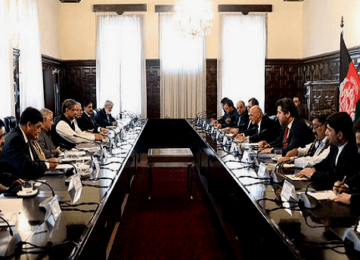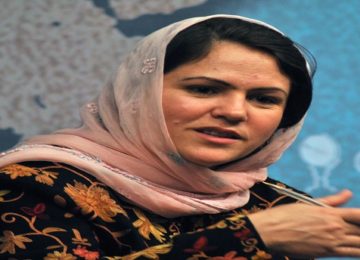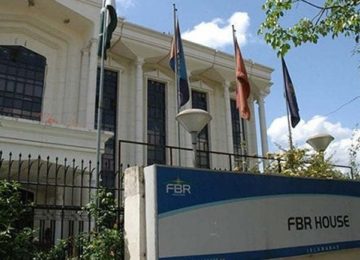The opiate economy, as measured by the farm-gate value of opium, together with revenues from heroin production and trafficking of opiates to the Afghan borders, has become a crucial component of the Afghan economy, a recently released UNODC socio-economic survey found. This has evolved after years of increasing opium cultivation in the country. But, what are the legal means to fight this illicit economy scourge? AAN’s Jelena Bjelica (with input from Ehsan Qaane and Rohullah Sorush) looks atthe counter-narcotics legal provisions and examines whether some of the legal mechanisms might restore benefits for the state from these trends in the illicit economy.
The Afghan opiate economy was worth between 4.1 to 6.6 billion USD in 2017. This represented 20 to 32 per cent of GDP, the UNODC said in its latest socio-economic survey released in mid-May 2018 (see here). This value exceeded by far the value of the country’s licit exports of goods and services in 2016 (6.9 per cent of GDP). It’s worth roughly equalled the value of the entire licit agricultural sector of the country, which constituted 23 per cent of GDP in 2016/2017, the UNODC found. In its press release the UNODC also said that “opium poppy has become a crucial component of the Afghan economy that secures the livelihoods of many Afghans who engage in cultivation, work on poppy fields or partake in the illicit drug trade.”
In 2017, Afghanistan produced more opium paste than ever before, some 9,000 metric tons according to the UNODC estimate. This compared to 4,800 metric tons in 2016 (see this AAN analysis). In the same year, the Counter-Narcotics Justice Center (CNJC), set up by the Afghan Government in May 2005 with a mandate derived from the Counter Narcotics Law to investigate and prosecute all serious intoxicating drinks and drug-related offences from across the country, in its annual report for 2017 said that the primary court of CNJC convicted 671 suspects. Most cases that ended up in the court were for small amounts of drugs that are punishable by a penalty. This, taken together with a symbolic number of seizures by the Afghan law enforcement agencies (more on this below), means that the country which has almost no legal consequences allows, if not nurtures, the production of over 90 per cent of the world’s illicit needs in opiates, ie opium, and it derivatives – morphine and heroin.
The story of the two laws
Since 2001, three counter-narcotics laws have been adopted in Afghanistan. The first was adopted in 2005. This had been drafted with the support of the UK, the then lead donor country on counter-narcotics. This also established the legal foundations for the CNJC. The second was adopted in 2010 and aimed to address rising cultivation levels that had occurred around 2007. It was then that Afghanistan produced 7,400 metric tons of opium; a record high production level until 2017. The most recent revision of the law began in 2015 to address a gap in criminal provisions related to synthetic drugs; the production and consumption of which had become more widespread in the country (see this AAN analysis). Each law resulted in harsher punishments for crime-related law-breaking. While the 2005 law mainly prescribed fines for drug trafficking, the 2010 law introduced prison sentences for the same crimes. Finally, the new 2018 law introduced even harsher prison sentences than 2010 law. However, it seems that the new counter-narcotics law (available here in Dari/Pashto) that replaced the 2010 anti-drug law has been ill-fated from its inception. The Afghan media Radio Azadi and Pajhwok reported that the law was sent to the to the lower house of the Afghan parliament (Wolesi Jirga) in 2016 for discussion and subsequent approval (see here and here). This law has been discussed twice in the Wolesi Jirga. The first time was on 18 January 2017, when Muhammad Saleh Saljuqi, the member of the Health and Counter-narcotics Commission, said that the law was not ready to be presented to the house, because at the joint session of the representatives of standing commissions, the conflicting points about the law had not been resolved. The relevant commissions working on the law were justice and judiciary, legislative, health and counter narcotics. He asked the Speaker of the Wolesi Jirga for another chance to discuss the law. The second chance was given on 12 April 2017 but, due to still unresolved differences, the law was again referred to the commissions.
The differences mainly revolved around formalizing the cultivation of opium for medical purposes that had been stipulated in the draft law. Chaman Shah Etemadi, an MP from Ghazni province and the member of parliamentary commission on narcotic drugs told AAN: “The counter narcotic commission recommended to formalize the cultivation, but unfortunately as this was partially against the constitution, it did not secure enough votes, so it was deleted from the law.” The 2004 Constitution in the article 7 clearly says: “The state shall prevent all kinds of terrorist activities, cultivation and smuggling of narcotics, and production and use of intoxicants.” Although, some MPs were strongly for legalization of the cultivation, such as Nasima Niazi, an MP from Helmand and Saleh Muhammad Saljooqi, an MP from Herat, others, such as MP Abdul Sattar Khawasi from Parwan, remained firm in their position that such a provision would violate the Constitution. Finally, Abdul Rauf Ibrahimi, the speaker of the lower house, ruled that the article of the law is against the constitution and that it should be deleted. In the session held on 1 May 2017 when 122 MPs were present, the majority voted for the deletion of article in question and approved the remaining law in that same session of the Wolesi Jirga before sending this onto the president’s office.
On 17 June, the Wolesi Jirga speaker, Abdul Rauf Ibrahimi, complained to Tolo news that of 13 draft laws passed by the Wolesi Jirga and the Meshrano Jirga (Upper House of Parliament) and sent to the president, none had been processed; including the anti-drug law.
The law would stay on president’s desk for another six months until early 2018. It was issued on 24 February 2018, only ten days after the new Penal Code entered into force, ie nine months after it has been published in the Official Gazette on 15 May 2017. By then, the new counter-narcotics law had been stuck in the Parliament for a year (more or less the same period as the Penal Code) and had been on President’s desk for at least six months. It contained criminal provisions that had not been aligned with the Penal Code. A regular quarterly report by the US Special inspector general for Afghanistan reconstruction (SIGAR) published on 30 April 2018 (see here) noted that the new counter-narcotics law criminal provisions “would have superseded the new penal code and nullified the new penal code provisions.” This major oversight in the new law, led to the post-facto (ie after the law has been signed by the President and published in the Official Gazette) series of high-level meetings, which resulted in a decree repealing the criminal provisions part of the new law. (1) According to the SIGAR report:
The Council of Ministers held an extraordinary meeting where they approved the repeal of the criminal provisions of the new CNL [counter-narcotics law]. On March 6, the Ministry of Justice published on its website the decree repealing the criminal provisions of the new CNL. The decree is coupled with an amendment to the penal code (Article 916), which will now include the language repealing the criminal CNL [counter-narcotics law] provisions, thus maintaining the PC [penal code] as the criminal law of the land.
The entire chapter five of the new Penal Code is dedicated to trafficking of narcotics and where the punishments are pretty much aligned with the 2010 Law. This is with the exception of the trafficking of synthetic drugs and acetic anhydride, which have been added as new crimes (see footnote 1). It also carries higher sentences for narcotic drug-related crimes than the 1976 penal code. Also, it authorises confiscating assets (including land, structures, and vehicles) used in, or earned through, illicit drug production, and trafficking.
What has not been repealed from the new law?
Stripped of its criminal provisions, the law still has something to offer. The mechanism for policy-making and its implementation is much stronger. Its authority and duties are much clearer than in the old law and will stay in place. In the new law, the mechanism, as one body, has three parts, including the High Commission for making policies (articles 5 and 6), the provincial and district commissions for implementing the policies (article 7), and the oversight committee for the implementation of the policies (article 8). The Ministry of Counter Narcotics acts as the secretariat of the High Commission (article 5).
The High Commission consists of one member of the Supreme Court, nineteen minsters and four heads of general directorates, ie almost 80 per cent of the cabinet members, and is chaired by the President or one of the vice-presidents (article 5). The commission is in charge of making all necessary and related policies and strategy. In the old law, the High Commission had only ten members at the deputy level and was chaired by the Minister of Counter Narcotics (article 6). It was in charge of implementing policies but without having the authority to make them. Nevertheless, the establishment of the High Commission for counter-narcotics also conforms to the latest trend in Afghanistan. This saw, under President’s Ghani lead, over 15 high commission and councils established since 2014, all being chaired by the president. The high commissions include those working on development issues, eg, the High Council on Rule of Law and Anti-Corruption; the High Council on Land and Water; the High Council on Urban Development; the High Council on Poverty Reduction, Service Delivery and Citizen Engagement; the High Council on Culture, Education and Human Capital and the Economic High Council. It also includes those working on security issues, such as the High Council on National Security, the High Council on Migration, and so.
Under the new law, the implementation of the strategy and policies is given to the provincial and district commissions (article 8). The duties and responsibilities of the commissions remain as they were under the old law. However, the combination of the commissions has expanded to 24 members, including the local governors.These commissions consist of the highest representatives of ministries (except the Ministry of Foreign Affairs, which does not have local offices) and general directorates, which are the members of the High Commission, also at the provincial and districts level. The provincial commissions are chaired by the provincial governors and the districts commissions are chaired by the district governors. Principally, it was seen as being wise to involve all pertinent bodies in the implementation processes. However, practically, it would prove difficult to manage this.
The old law did not have a mechanism to oversee the activities of individuals or companies, and that could deal with licences, process, purchase, sell, storage, distribution, commissioning, import and export, traffic and supply of narcotics drugs. In the new law, a committee of seven experts from six ministries will oversee and control the activities of non-governmental companies and individuals and will grant a permit or license for the preparation, process, purchase, sell, storage, distribution, commissioning, import and export, traffic and supply. This, mainly, has to do with the article 19 of the new law, which states:
The confiscated drugs in agreement with International Narcotics Control Board will either be converted to medicine or sold to one of the countries that has licence. If INCB disagrees that the drugs be sold or used in making medicine, the prosecutor will take the case to a court and the court will issue an order to destroy it.
The 1961 Convention on Narcotic Drugs does allow for the release of seized materials for licit use. The head of UNODC office in Kabul, Mark Colhoun, told AAN that this fall under the licit control mechanisms for opiates, as well as other drugs, and INCB works with governments to estimate annual requirements of amounts required for medical use. “The provisions of the law would therefore appear to be in line with the requirements under the international conventions,” he said.
However, the article in the new Afghan Law does not specify which kind of drugs. AAN’s reading of the article 24/5 (b) of the 1961 Convention is that the release of seized material for licit use only applies to opium. The quoted article says that a country, which is a party to the Convention, is not prevented “from producing opium sufficient for its own requirements; or from exporting opium seized in the illicit traffic, to another Party in accordance with the requirements of this Convention.” Hence, a question arises as to whether the wording of article 19 of the new Afghan counter-narcotics law was, as usual, sloppy, or whether there was something more to it. AAN sent an email to INCB in mid-April 2018 with a request for a comment, but had not receive an answer by the time this dispatch was published.
Can this work in practice?
The new law’s remaining enforceable parts seem to intend to restore opiate-related economic trends to benefit the state. However, for the state to benefit from the illicit economy, seizures of drugs in Afghanistan would have to increase significantly. According to UNODC, Afghanistan in 2016 (see page 69 of the latest socio-economic survey), seized around 47 tons of opium out of the 4,800 metric tons produced in the same year (see this AAN analysis). This represents less than one per cent which, if added to the 4.6 tons of heroin seized in 2016 equals approximately 46 tons of opium (using a conversion rate for opium to heroin of 1:10). Together, this still makes for less than two per cent of overall’s country opium production in 2016. No morphine had been seized in 2016, according to UNODC. In fact, the new US Special inspector general for Afghanistan reconstruction (SIGAR) report on counter-narcotics, published on 14 June 2018 noted that “the amount of opium seized over the last ten years is equivalent to about five percent of the estimated opium production in 2017 alone.”
There are other considerations to be taken into account. David Mansfield, Senior Fellow at the London School of Economics International Drug Policy Unit and long-term adviser to AREU warned that past attempts by other countries to export products derived from seized opium were thwarted by the protests of those who produce licit opium and incur the costs of control and regulation. Past practice suggests it will not simply be a case of finding a buyer for illegally produced opiates and selling them on. The outcome will be governed by the INCB and diplomacy,” he said.
Another challenge has to do with a commercial nature of the problem, which is a bigger one. “There are few pharmaceutical companies that want raw opium these days,” he said, adding that is far better to have derivatives that have “higher value to weight ratio, are easier to transport and control, and contain less or no waste.” Yet, if the international demand is not for opium, then Afghanistan would have to invest in its own processing capacity, which would need to meet international pharmaceutical standards. Mansfield added:
“Turkey received international donor support for its processing in Bolvadin in Afyon in the 70s. It’s hard to believe in the current environment in Afghanistan there would be either international support from donors or the private sector – particularly given the challenges above that would indicate an uncertain international market for the final product.”
Conclusion
The story of the new counter-narcotic law shows the extent to which a lack of coordination creates stumbling blocks, as well as all the unnecessary work it generates for some parts of government. Yet, it raises the question: what was the purpose of harsher punishments for smaller traffickers and drug users, stipulated in the repealed criminal provision of the new counter-narcotics law?Presumably, such policies had been inserted to target local drugs consumption market, which according to UNODC’s latest socio-economic survey (see here) is estimated to be worth around 0.5 per cent of the country’s GDP. (2) This compared to a value of 20 to 32 per cent of GDPof an entire illicit agricultural sector, shows that the legislators and the drafters have been more concerned with a single tree, while the forest is on fire. It also shows that a visual proximity of the problem, a number of drug users hanging around Pol-e-Soktha bridge (see this AAN analysis), located in west Kabul, prompt harsher legal responses when it should have prompted a more human approach. Nevertheless, it is also interesting that the Parliament stumbled for six months in the discussion about legalization of cultivation as to whether this was against the Constitution. Meanwhile, at the same time, it passed the law that suspended the new Penal Code. All together, it seems as though, aside from the usual sloppiness in managing the legal matters, counter-narcotics remain very low on the agenda of the Afghan government, and that the problem continues to be addressed from an exclusively Kabul perspective.
(1) What has been repealed from the new law?
The repealed criminal provision of the counter-narcotics law included all crimes that have been listed in the old law (for an English version of the old law see here) and, in addition, two new provisions related to trafficking of acetic anhydride and synthetic drugs. The sentences, for example, for trafficking of acetic anhydride – a key substance used as precursor to process opium paste into morphine or heroin, and the trafficking of synthetic drugs, such as MDMA or methamphetamine (see this AAN analysis about booming synthetics drugs industry in Afghanistan) – could be from six months to 15 years in prison, depending on the amount of acetic anhydride or synthetic drugs. However, the gravity of the sentence for amounts of these two substances, of course, differed. For acetic anhydride, six months punishment is given for trafficking of less than 25 grams of this substance, while the same punishment is for less than one gram of synthetic drugs. The Penal Code, on the other hand, foresees fines in lieu of a short prison sentence for such small amounts.
The punishment of other criminal acts related to the narcotics and intoxicants had been increased extremely in the new law. Thus this was repealed by the Ministry of Justice decree. For the purpose of historical record and to list just a few: in some cases, sentences had been increased 12 times more and, in some cases, the balance between the act of crime and its punishment did not make any sense.For example, in the new law, the act of trafficking cannabis derivate [chars] will be punished by sentence in prison from two to three years if the amount is more than 100 grams and less than 500 grams. In the old law, the same act was punished by two to three months in prison. In the new Penal Code, the same act is punished by 6 months up to one year’s imprisonment.
(2) UNODC estimated from the 2009 drug use survey that, the number of opium and heroin users in the country was 230,000 (210,000-260,000) and 120,000 (110,000-140,000), respectively. These numbers account for poly-drug use, i.e. one person is counted in both groups if using both opium and heroin.
By Special Arrangement with AAN. Original link.
Disclaimer: Views expressed on this blog are not necessarily endorsed or supported by the Center for Research and Security Studies, Islamabad.








